The bench press is one of the most fundamental exercises for building upper body strength. Whether you are a beginner or an experienced lifter, mastering the bench press form is essential for maximizing gains and preventing injury.
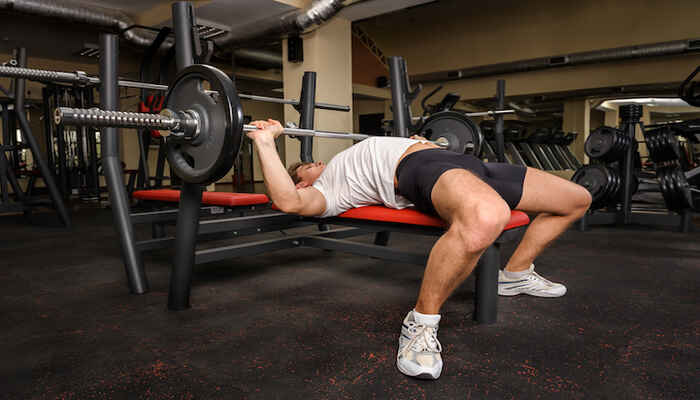
What is the Bench Press?
The bench press is a compound movement that primarily targets the chest, shoulders, and triceps. This exercise can be performed using barbells, dumbbells, or chest press machines. Proper technique and progression are key to increasing strength and avoiding injury.
You may also like: Ultimate Guide to Creatine: Benefits, Side Effects, and Types
Bench Press Variations
Barbell Flat Bench Press

The barbell bench press is the most common and widely practiced variation of the bench press. Performed on weight benches, this movement is a staple in powerlifting, bodybuilding, and general strength training. It primarily targets the chest press muscles, including the pectoralis major, anterior deltoids, and triceps. Due to its ability to handle heavy loads, the barbell bench press is one of the most effective exercises for upper body strength development.
Benefits of the Barbell Bench Press
- Strength Progression – Using a barbell allows for incremental weight increases, making it easier to track strength gains over time. Many lifters use a bench press calculator to estimate their one-rep max and structure their workouts accordingly.
- Muscle Growth – The bench press is highly effective for hypertrophy, particularly when combined with variations such as the incline bench press, decline bench press, and close grip bench press to target different areas of the chest.
- Compound Movement – Unlike isolation exercises, the barbell bench press engages multiple muscle groups, making it a time-efficient way to build overall upper body strength.
- Improved Athletic Performance – Many sports require upper body pushing power, and the barbell bench press helps enhance explosive strength.
Dumbbell Bench Press
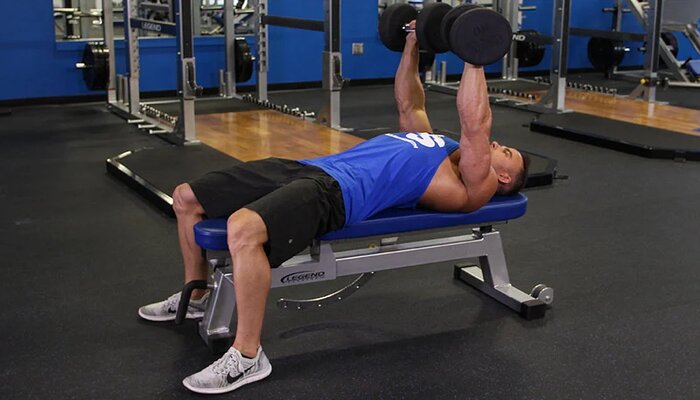
The dumbbell bench press is a highly effective alternative to the barbell bench press, offering a greater range of motion and increased muscle activation. Unlike the barbell variation, which limits movement to a fixed path, the dumbbell bench allows for a more natural pressing motion. This results in better chest contraction and improved shoulder health.
Benefits of the Dumbbell Bench Press
- Increased Range of Motion – The dumbbell bench press allows the arms to move deeper at the bottom of the movement, stretching the chest muscles and enhancing muscle engagement. This is particularly beneficial when performing variations like the incline dumbbell bench press or db incline chest press, which target the upper chest.
- Improved Muscle Activation – Since each arm moves independently, stabilizer muscles are more engaged compared to the barbell version. This enhances overall muscle coordination and strength. Studies show that the db incline press and db press incline variations particularly activate more upper chest fibers than their barbell counterparts.
- Better Shoulder Health – The independent movement of dumbbells reduces strain on the shoulders, allowing for a more natural pressing angle. Lifters who experience discomfort with the bench press machine or bench machine press often find dumbbells to be a safer alternative.
- Fixing Muscle Imbalances – Unlike the chest bench press machine, which allows dominant muscles to take over, dumbbells force both sides of the body to work equally. This is beneficial for correcting strength imbalances.
You may also like: Testosterone: The Key Hormone for Strength, Muscle Growth, and Vitality
Incline Bench Press
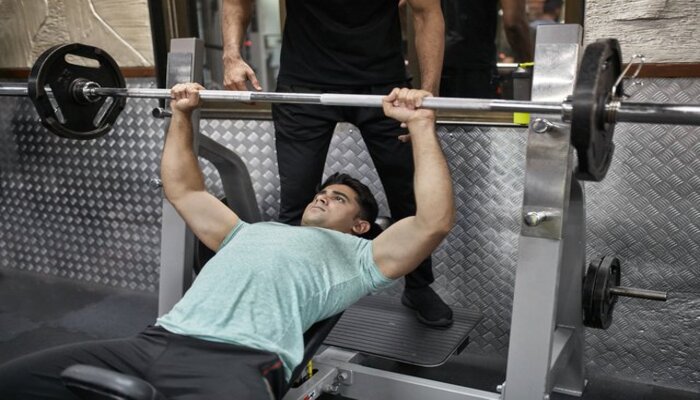
The incline bench press targets the upper chest more effectively. It is performed at an incline bench press angle of around 30 to 45 degrees. Variations include the db incline chest press, db incline press, and db press incline. This angle shifts emphasis from the mid-chest, engaging the clavicular head of the pectoralis major. Utilizing dumbbells allows for a greater range of motion and independent arm movement, promoting balanced muscle development and reducing strength imbalances.
Benefits of the Incline Bench Press
- Upper Chest Emphasis – Unlike the traditional bench press, which works the entire pectoral region, the incline bench press places more tension on the upper chest, contributing to a fuller and more balanced chest development.
- Improved Shoulder Strength – The inclined position increases activation of the anterior deltoids, making it a great exercise for improving shoulder stability and strength.
- Versatile Equipment Options – The incline bench press can be performed with different equipment, such as dumbbell bench press, bench press machine, and chest press machines.
- Enhanced Range of Motion – When performed with dumbbells, such as in the incline dumbbell bench press or dumbbell press, the movement allows for a deeper stretch in the chest, leading to greater muscle activation.
Decline Bench Press

The decline bench press shifts focus to the lower chest. This variation is useful for building a well-rounded chest. By positioning the bench at a decline angle, typically between 15 and 30 degrees, the exercise targets the sternal head of the pectoralis major. This downward angle allows for a greater range of motion and increased emphasis on the lower pectoral muscles, contributing to a more defined and complete chest development.
Benefits of the Decline Bench Press
- Lower Chest Development – The decline bench press places greater stress on the lower pectoral muscles, helping to develop a fuller and more defined chest.
- Reduced Shoulder Strain – Unlike the incline bench press, which engages more of the shoulders, the decline bench press minimizes shoulder involvement, making it a safer option for those with shoulder discomfort.
- Increased Pressing Strength – Since the decline angle reduces the range of motion, lifters often find they can lift heavier weights compared to a flat barbell bench press. This can improve overall pressing strength.
- Variety of Equipment Choices – The exercise can be performed using a barbell bench press, dumbbell bench press, or even machines like the bench press machine or chest bench press machine for controlled movement.
Close Grip Bench Press
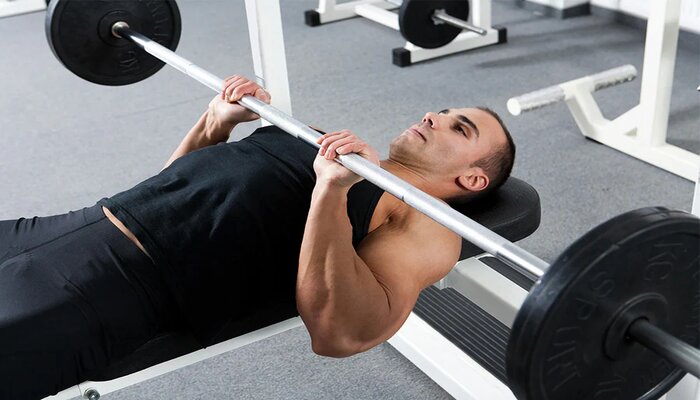
The close grip bench press is a powerful variation of the bench press that places greater emphasis on the triceps, while still engaging the chest press muscles and shoulders. By narrowing the hand placement on the bar, this exercise reduces chest involvement and shifts the workload to the triceps, making it an excellent movement for developing pressing strength and arm size.
Benefits of the Close Grip Bench Press
- Increased Triceps Activation – Compared to the traditional barbell bench press, the close grip bench press engages the triceps more, leading to greater strength and muscle growth in the arms.
- Improved Lockout Strength – The movement strengthens the triceps, which are crucial for the lockout phase in pressing movements like the bench press machine, bench machine press, and incline bench press.
- Reduced Shoulder Strain – The narrower grip minimizes shoulder stress, making it a safer alternative for lifters who experience discomfort with wider-grip pressing variations.
- Carries Over to Other Lifts – Strengthening the triceps with the close grip bench press enhances performance in exercises like the dumbbell bench press, bench press machine, and overhead presses.
You may also like: The Ultimate Guide to Deadlifts: Benefits, Variations, and Proper Form
Equipment for Bench Press
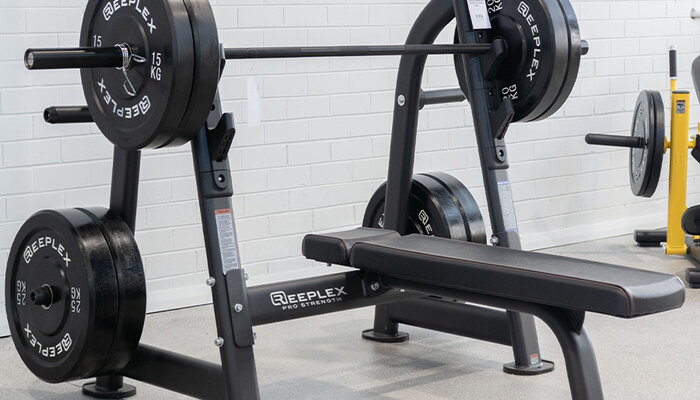
Various chest press equipment and benching weights are used to perform the bench press effectively. Bench press machines and bench machine press options are available for controlled resistance training. Additionally, a workout bench with weights is essential for a proper setup.
Various chest press equipment and benching weights are used to perform the bench press effectively, ensuring a safe and productive workout. Adjustable bench press setups are crucial for customizing the exercise to individual needs and variations, such as incline or decline presses.
Olympic barbells and weight plates offer progressive resistance, allowing for gradual strength gains. Bench press machines and bench machine press options are available for controlled resistance training, ideal for beginners or those focusing on specific muscle activation.
Additionally, a stable workout bench with weights is essential for a proper setup, providing stability and support. Consider using bench press racks or power cages for enhanced safety, especially when lifting heavier loads.
Exploring high quality home gym bench press options makes this effective exercise accessible and convenient for home gyms.
How to Bench Press Properly
- Lie flat on the bench for working out, ensuring feet are planted firmly on the ground. Lie flat on the bench for working out, ensuring your feet are firmly planted to generate leg drive, which enhances power transfer during the bench press. A strong base stabilizes the lift, engages the core, prevents excessive back arching, and helps push through sticking points, improving performance in barbell and dumbbell bench press variations.
- Grip the barbell slightly wider than shoulder-width. Grip the barbell slightly wider than shoulder-width to optimize chest engagement and pressing power during the bench press. A wider grip reduces the range of motion, allowing for greater chest activation while minimizing strain on the triceps. Proper grip placement ensures stability, enhances control, and improves performance in barbell bench press variations.
- Lower the bar to your chest while maintaining control. Lower the bar to your chest while maintaining control to ensure proper muscle engagement and prevent injury during the bench press. A slow, controlled descent maximizes tension on the chest, improves stability, and reduces strain on the shoulders. This technique applies to the barbell bench press, incline bench press, and decline bench press.
- Press the weight up explosively while keeping your core engaged. Press the weight up explosively while keeping your core and back engaged to maximize power and stability during the bench press. Engaging your core prevents excessive arching, while an explosive push recruits more muscle fibers for strength gains. This technique applies to the barbell bench press, incline bench press, and dumbbell bench press variations.
- Repeat for the desired number of reps.
Muscles Worked in Bench Press (Primary)
The bench press muscles worked include the pectorals, triceps, and deltoids. The incline bench press muscles worked focus more on the upper chest and shoulders.
Below is a breakdown of muscle groups involved in a shoulder-width grip bench press, along with their approximate contribution and the specific part of the muscle they engage.
Pectoralis Major (Chest) – 50-60% Contribution

The sternocostal head (lower chest) is the primary mover in a flat bench press, generating most of the force. This portion of the pectoralis major is best aligned with the horizontal pressing motion of the flat bench, making it the dominant contributor. While the triceps and shoulders assist, the lower chest bears the brunt of the load.
The clavicular head (upper chest) is more engaged in the incline bench press variations like the db incline chest press. The inclined angle targets the upper chest by aligning the motion with the muscle fibers of the clavicular head, enhancing activation and development.
Triceps Brachii – 15-25% Contribution

The long head assists in lockout strength. This portion of the triceps brachii crosses both the shoulder and elbow joints, allowing it to contribute significantly during the final phase of pressing movements. Its role becomes more prominent as the arms approach full extension, providing crucial support in the lockout portion of exercises like the bench press.
The lateral and medial heads are heavily involved in extending the elbows, especially in the close grip bench press. These heads are primarily responsible for powerful elbow extension and are highly activated during close grip variations due to the narrower hand placement emphasizing triceps engagement.
Anterior Deltoid (Front Shoulder) – 10-15% Contribution

Assists in pressing movements, particularly in the initial phase of lifting the bar from the chest. This action primarily involves the anterior deltoid, which plays a supporting role in horizontal pressing exercises like the flat bench press. It helps initiate movement from the bottom position, stabilizing the shoulder joint and contributing to upward force.
More involved in the incline bench press due to the pressing angle. The incline position shifts the emphasis toward shoulder flexion, which recruits the anterior deltoid to a greater extent. This increased involvement complements upper chest activation and supports efficient movement throughout the incline pressing motion.
Muscles Worked in Bench Press (Secondary)
Serratus Anterior – 5-10% Contribution

Serratus anterior stabilizes the scapula during pressing movements. This muscle anchors the scapula against the ribcage, preventing winging and allowing for efficient force transfer from the upper body during exercises like the bench press. Proper scapular stability is essential for safe and effective pressing.
Plays a key role in controlled lowering and pressing phases. The serratus anterior actively engages to maintain scapular positioning as the bar is lowered to the chest and pressed back up. This ensures optimal shoulder mechanics, reduces injury risk, and enhances overall pressing strength by providing a stable base for upper body movement.
Latissimus Dorsi (Lats) – 5-10% Contribution

Latissimus dorsi provides stability during the eccentric (lowering) phase. During the descent of pressing movements like the bench press, the lats act as stabilizers, controlling the bar path and preventing excessive shoulder movement. This control ensures a smooth, safe lowering phase while maintaining tension throughout the lift.
Helps maintain proper positioning of the shoulders. By keeping the shoulders retracted and down, the latissimus dorsi supports optimal shoulder alignment and joint integrity. This not only reduces the risk of injury but also enhances pressing efficiency by creating a solid base for the chest and arms to generate force.
Forearms and Grip Muscles – 3-5% Contribution
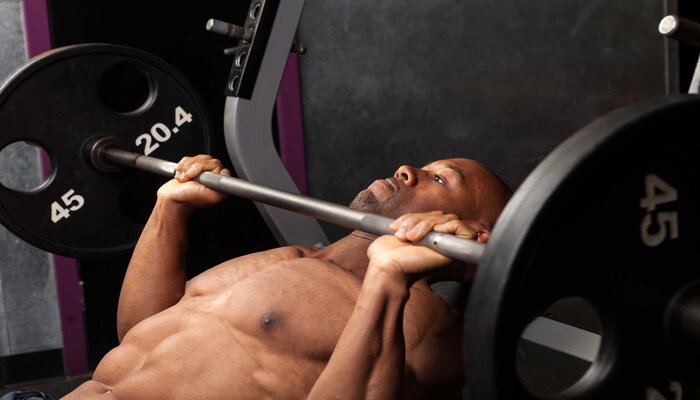
Forearms and grip muscles are responsible for stabilizing the bar during the lift. These muscles play a crucial role in maintaining wrist alignment and controlling the bar path throughout the pressing movement. Their engagement ensures that the bar remains steady, especially under heavy loads.
Essential for maintaining a secure grip, particularly in dumbbell bench press variations. Unlike barbells, dumbbells require independent control of each hand, increasing the demand on grip strength and forearm stability. A strong grip not only prevents slippage but also enhances overall pressing performance by allowing better force transmission through the arms and into the weights.
You may also like: Leg Press: Maximise Leg Gains With Our Guide
Bench Press Records and Averages
The world record bench press showcases the pinnacle of strength achievements, while the bench press world record categories highlight impressive lifts. For general lifters, knowing the average bench press by age provides a benchmark for progress.
World Record Bench Press
The world record for raw (no equipment) bench press is 355 kg (782.6 lb) set by Julius Maddox, while the equipped record is 635 kg (1,401 lb) held by Jimmy Kolb. The average bench press for a female lifter is around 51 kg (1RM), considered intermediate strength.
Average Bench Press by Age and Experience
Bench press strength varies among individuals, but general guidelines for a barbell bench press (1-rep max) are:
- Untrained: ~50-70% of body weight
- Beginner: ~80-100% of body weight
- Intermediate: ~100-130% of body weight
- Advanced: ~130-160% of body weight
- Elite: 160%+ of body weight
For example, an average bench press by age and weight might look like this for a 75 kg (165 lb) male lifter:
- Beginner: ~60 kg (135 lbs)
- Intermediate: ~90 kg (200 lbs)
- Advanced: ~120 kg (265 lbs)
- Elite: 150 kg+ (330 lbs)
Bench Press Standards Across Variations
Different bench press variations impact strength levels:
- Incline Bench Press: Generally 10-20% lower than flat bench due to greater shoulder activation.
- Decline Bench Press: Often slightly higher due to reduced range of motion.
- Close Grip Bench Press: Typically weaker than standard grip, as it emphasizes the triceps.
- Dumbbell Bench Press: Usually lower total weight due to stabilization demands, but offers better range of motion.
By tracking progress using a bench press calculator and maintaining proper technique, you can steadily improve their strength and aim for new personal records.
Common Mistakes and How to Avoid Them
The bench press is a fundamental exercise, but many lifters make mistakes that reduce effectiveness and increase injury risk. Below are the most common errors and how to fix them.
1. Improper Grip Width
- Mistake: Gripping the bar too wide or too narrow can strain the wrists and shoulders.
- Fix: Use a grip slightly wider than shoulder-width for a balanced barbell bench press. For variations like the close grip bench press, keep hands just inside shoulder width.
2. Flaring the Elbows Out
- Mistake: Allowing elbows to flare out at 90° puts excessive strain on the shoulders.
- Fix: Keep elbows at about a 75° angle to engage the chest while protecting the joints.
3. Bouncing the Bar Off the Chest
- Mistake: Using momentum by bouncing the bar reduces muscle activation and increases injury risk.
- Fix: Lower the weight with control and pause briefly before pressing explosively.
4. Lack of Leg Drive
- Mistake: Not using leg drive reduces power transfer.
- Fix: Keep feet firmly planted on the ground and push through them to stabilize and generate force.
5. Not Controlling the Descent
- Mistake: Dropping the bar too quickly leads to poor form and instability.
- Fix: Lower the weight in a controlled manner, keeping tension on the chest and triceps.
6. Incomplete Range of Motion
- Mistake: Not lowering the bar all the way to the chest limits muscle activation.
- Fix: Perform a full range of motion to maximize gains and maintain proper bench press form.
7. Overarching the Lower Back
- Mistake: Excessive arching can strain the spine.
- Fix: Maintain a natural arch while keeping the glutes and upper back in contact with the bench for working out.
8. Lifting Too Heavy or Too Light
- Mistake: Using excessive weight leads to poor form and increased injury risk, while lifting too light may not provide enough stimulus for muscle growth.
- Fix: Choose a challenging but manageable weight, typically 75-85% of your 1-rep max, and track progress using a bench press calculator.
9. Neglecting Warm-Up
- Mistake: Skipping a proper warm-up increases the risk of injury and reduces strength output.
- Fix: Perform dynamic warm-ups, such as arm circles, shoulder mobility drills, and light dumbbell bench press sets, to activate muscles and improve performance.
By avoiding these mistakes, lifters can enhance their performance across variations like the incline bench press, decline bench press, and bench press machine, leading to better strength and muscle gains.
Conclusion
The bench press is a versatile exercise that offers immense benefits when performed correctly. Whether you are using a bench press machine, incline dumbbell bench press, or traditional barbell press, incorporating workouts with bench into your routine will enhance strength and muscle growth. Keep refining your proper bench press form to achieve long-term progress and strength gains.
By understanding what does bench press work, you can tailor your training for maximum results. Keep pushing your limits, track your lifts using a bench press set, and aim for new personal bests!
You may also like: Cardio for Weightlifters: Best Low-Impact Options: Swimming & Cycling
FAQs (Frequently Asked Questions)
To bench press, lie on a weight bench, grip the bar slightly wider than shoulder-width, lower it to your chest, and press it back up. Maintain proper bench press form with leg drive and core engagement for stability and strength.
The bench press primarily works the chest, shoulders, and triceps, with secondary engagement of the lats and forearms. Variations like the incline bench press and close grip bench press shift emphasis to different muscle groups for balanced development.
The bench press works the pectoralis major (chest), triceps, anterior deltoid (shoulders), serratus anterior, and lats. The barbell bench press emphasizes overall chest development, while the dumbbell bench press provides a greater range of motion.
A standard Olympic bench press bar weighs 20 kg (45 lbs). Some gyms also have 15 kg (35 lbs) bars for beginners and 25 kg (55 lbs) powerlifting bars for heavier lifting.
The bench press works the chest (pectorals), shoulders (deltoids), and triceps, with minor activation of stabilizing muscles like the lats and forearms. The incline bench press shifts more emphasis to the upper chest.
To increase bench press, focus on progressive overload, improve triceps and shoulder strength, and practice proper bench press form. Accessories like the bench press machine and incline dumbbell bench press help build pressing power.
A gorilla’s estimated strength suggests it could bench press over 1,800 lbs (800 kg) due to its immense upper body power, but this is theoretical as gorillas do not lift weights in the wild.
The average man can bench press around 60-90 kg (135-200 lbs) depending on training experience. Beginners lift closer to body weight, while advanced lifters often exceed 1.5 times their weight.
The world record bench press (equipped) is over 500 kg (1,100 lbs), while the raw (unequipped) record exceeds 350 kg (770 lbs). Records vary based on weight class and federation rules.
No, the bench press primarily works the chest, shoulders, and triceps. The biceps act as stabilizers but are not a primary mover. Direct biceps training like curls is needed for growth.
The bench press works the pectorals, anterior deltoids, triceps, and serratus anterior. Variations like the incline bench press target the upper chest, while the close grip bench press emphasizes the triceps.
The bench press bar weighs 20 kg (45 lbs) for standard Olympic bars. Lighter training bars at 15 kg (35 lbs) are also used, and 25 kg (55 lbs) power bars exist for advanced lifting.
A good bench press depends on body weight and experience. Lifting 1.25-1.5 times body weight is strong, while elite lifters press 2 times their body weight.
A bench press bar costs between ₹5,000–₹20,000 depending on quality, weight, and brand. Olympic bars are more expensive than standard bars.
Push-ups use body weight and require core engagement, while the bench press allows heavier loading and the dumbbell fly isolates the chest with a greater stretch.
The average bench press for a trained individual is around 1 to 1.5 times body weight, depending on training level, weight class, and age.
Yes, the bench press works shoulders, specifically the anterior deltoid. However, overhead pressing is better for full shoulder development.
To do incline bench press, set the weight bench to a 30-45° incline, grip the bar slightly wider than shoulder-width, lower it to the upper chest, and press up.
To improve bench press, strengthen the triceps, shoulders, and chest, maintain proper bench press form, and incorporate accessory lifts like the dumbbell press and incline benchpress.
To do dumbbell bench press, lie on a workout bench with weights, hold dumbbells at chest level, press them upward while keeping control, and lower slowly for a full range of motion.

